“On-Line” Heating Emissions Based on WRF Meteorology—Application and Evaluation of a Modeling System over Greece
Abstract
:1. Introduction
2. Materials and Methods
2.1. Modeling Application
2.2. Emissions Inventory for Greece
2.2.1. Heating
- -
- The mean annual fuel consumption of gas oil and natural gas for each Greek prefecture for the period 2015–2017, which have been derived from the Hellenic Statistical Authority and the Hellenic Gas Transmission System Operator (www.desfa.gr, accessed on 1 February 2019), respectively.
- -
- The mean annual residential consumption of wood and biomass for the period 2015–2016 on a national level, which has been provided by the Center for Renewable Energy Sources and Saving (www.cres.gr, accessed on 1 February 2019) for the estimation of biomass burning emissions. In addition, concerning the type of technology/practice used for biomass burning, it was assumed that 66% of households use fireplaces and 34% woodstoves [9].
- -
- “On-line” heating emissions have been estimated based on annual statistical data of the Heating Degree Days (HDD) of Greek prefectures and using the hourly meteorological data derived from the application of the WRF model for the cold period (January–April and October–December) of 2015. In particular, the annual heating emissions per Greek prefecture were converted to mean daily heating emissions per degree day (°Cday) using statistical data of the mean annual HDD per Greek prefecture. Following this, a further spatial distribution on a municipality level was performed using population data on the municipality level (i.e., the number of households per fuel type used for heating purposes for each Greek municipality derived from the Hellenic Statistical Authority). The mean daily heating emissions per HDD from biomass burning and other sources for each municipality of Greece were spatially distributed on the 6 × 6 km2 and 2 × 2 km2 resolution grids. The potential mean daily emissions (g/°Cday) from biomass burning and other sources were firstly distributed on a weekly basis using temporal profiles. The final daily gridded pollutant emissions have been calculated based on the hourly meteorological data of the WRF model for the year 2015 and the hourly profiles. More specifically, the HDD for each simulated day of WRF and each grid cell has been estimated based on the hourly air temperature Th and the reference temperature Ti used for the HDD estimations, which was defined at 18 °C [34] as follows:
- -
- Annual “static” heating emissions on a prefectural level have been spatially distributed over the 6 × 6 km2 (Greece) and 2 × 2 km2 (Thessaloniki) resolution grids using only population data on the municipality level (i.e., number of households per fuel type use for heating purposes for each Greek municipality derived from the Hellenic Statistical Authority). Static heating emissions from oil and natural gas (other sources) have been distributed monthly using only static monthly profiles derived by the database of CAMS-REG v2.2.1. The temporal distribution on a weekly and hourly basis was derived using the static temporal profiles of CAMS-REG v2.2.1 and Athanasopoulou et al. [8] for oil and natural gas (other sources) and biomass burning (wood/biomass) emissions, respectively.
2.2.2. Other Sources
2.2.3. Chemical Distribution
3. Results and Discussion
3.1. Evaluation of the Meteorological Model
3.2. Heating Emissions in Greece
3.3. Evaluation of the Modeling System
- “On-line” heating emissions scenario (On-line SCN);
- “Static” heating emissions scenario (Static SCN).
4. Conclusions
Supplementary Materials
Author Contributions
Funding
Institutional Review Board Statement
Informed Consent Statement
Data Availability Statement
Acknowledgments
Conflicts of Interest
References
- European Environment Agency (EEA). Air Quality in Europe-2018 Report (No. 12); European Environment Agency: København, Denmark, 2018; ISSN 1977-8449. Available online: https://www.eea.europa.eu/publications/air-quality-in-europe-2016 (accessed on 1 March 2021).
- Markakis, K.; Poupkou, A.; Melas, D.; Tzoumaka, P.; Petrakakis, M. A Computational Approach Based on GIS Technology for the Development of an Anthropogenic Emission Inventory of Gaseous Pollutants in Greece. Water Air Soil Pollut. 2010, 207, 157–180. [Google Scholar] [CrossRef]
- Moussiopoulos, N.; Vlachokostas, C.; Tsilingiridis, G.; Douros, I.; Hourdakis, E.; Naneris, C.; Sidiropoulos, C. Air quality status in Greater Thessaloniki Area and the emission reductions needed for attaining the EU air quality legislation. Sci. Total Environ. 2009, 407, 1268–1285. [Google Scholar] [CrossRef] [PubMed]
- Panopoulou, A.; Liakakou, E.; Gros, V.; Sauvage, S.; Locoge, N.; Bonsang, B.; Psiloglou, B.E.; Gerasopoulos, E.; Mihalopoulos, N. Non-methane hydrocarbon variability in Athens during wintertime: The role of traffic and heating. Atmos. Chem. Phys. 2018, 18, 16139–16154. [Google Scholar] [CrossRef] [Green Version]
- Bolling, A.K.; Pagels, J.; Yttri, K.E.; Barregard, L.; Sallsten, G.; Schwarze, E.P.; Boman, C. Health effects of residential wood smoke particles: The importance of combustion conditions and physicochemical particle properties. Part. Fibre Toxicol. 2009, 6, 29. [Google Scholar] [CrossRef] [PubMed] [Green Version]
- Li, H.; You, S.; Zhang, H.; Zheng, W.; Zou, L. Analysis of the impacts of heating emissions on the environment and human health in North China. J. Clean. Prod. 2019, 207, 728–742. [Google Scholar] [CrossRef]
- Sarigiannis, D.A.; Karakitsios, S.P.; Kermenidou, M.; Nikolaki, S.; Zikopoulos, D.; Semelidis, S.; Papagiannakis, A.; Tzimou, R. Total exposure to airborne particulate matter in cities: The effect of biomass combustion. Sci. Total Environ. 2014, 493, 795–805. [Google Scholar] [CrossRef]
- Athanasopoulou, E.; Speyer, O.; Brunner, D.; Vogel, H.; Vogel, B.; Mihalopoulos, N.; Gerasopoulos, E. Changes in domestic heating fuel use in Greece: Effects on atmospheric chemistry and radiation. Atmos. Chem. Phys. 2017, 17, 10597–10618. [Google Scholar] [CrossRef] [Green Version]
- Fameli, K.-M.; Assimakopoulos, V.D. The new open Flexible Emission Inventory for Greece and the Greater Athens Area (FEI-GREGAA): Account of pollutant sources and their importance from 2006 to 2012. Atmos. Environ. 2016, 137, 17–37. [Google Scholar] [CrossRef]
- Kaskaoutis, D.G.; Grivas, G.; Theodosi, C.; Tsagkaraki, M.; Paraskevopoulou, D.; Stavroulas, I.; Liakakou, E.; Gkikas, A.; Hatzianastassiou, N.; Wu, C.; et al. Carbonaceous Aerosols in Contrasting Atmospheric Environments in Greek Cities: Evaluation of the EC-tracer Methods for Secondary Organic Carbon Estimation. Atmosphere 2020, 11, 161. [Google Scholar] [CrossRef] [Green Version]
- Saffari, A.; Daher, N.; Samara, C.; Voutsa, D.; Kouras, A.; Manoli, E.; Karagkiozidou, O.; Vlachokostas, C.; Moussiopoulos, N.; Shafer, M.M.; et al. Increased Biomass Burning Due to the Economic Crisis in Greece and Its Adverse Impact on Wintertime Air Quality in Thessaloniki. Environ. Sci. Technol. 2013, 47, 13313–13320. [Google Scholar] [CrossRef]
- Markakis, K.; Poupkou, A.; Melas, D.; Zerefos, C. A GIS based anthropogenic PM10 emission inventory for Greece. Atmos. Pollut. Res. 2010, 1, 71–81. [Google Scholar] [CrossRef] [Green Version]
- Markakis, K.; Katragkou, E.; Poupkou, A.; Melas, D. MOSESS: A New Emission Model for the Compilation of Model-Ready Emission Inventories—Application in a Coal Mining Area in Northern Greece. Environ. Model. Assess. 2013, 18, 509–521. [Google Scholar] [CrossRef]
- Skamarock, W.C.; Klemp, J.B.; Dudhia, J.; Gill, D.O.; Barker, D.M.; Duda, M.G.; Huang, X.Y.; Wang, W.; Powers, J.G. A Description of the Advanced Research WRF Version 3; U.S. National Center for Atmospheric Research: Boulder, CO, USA, 2008. [Google Scholar]
- Solomou, E.S.; Pappa, A.; Kioutsioukis, I.; Poupkou, A.; Liora, N.; Kontos, S.; Melas, D. Analog ensemble technique to post-process WRF-CAMx ozone and particulate matter forecasts. Atmos. Environ. 2021, 256, 118439. [Google Scholar] [CrossRef]
- Drosoglou, T.; Bais, A.F.; Zyrichidou, I.; Kouremeti, N.; Poupkou, A.; Liora, N.; Giannaros, C.; Koukouli, M.E.; Balis, D.; Melas, D. Comparisons of ground-based tropospheric NO2 MAX-DOAS measurements to satellite observations with the aid of an air quality model over the Thessaloniki area, Greece. Atmos. Chem. Phys. 2017, 17, 5829–5849. [Google Scholar] [CrossRef] [Green Version]
- Liora, N.; Poupkou, A.; Giannaros, T.M.; Kakosimos, K.E.; Stein, O.; Melas, D. Impacts of natural emission sources on particle pollution levels in Europe. Atmos. Environ. 2016, 137, 171–185. [Google Scholar] [CrossRef]
- Liora, N.; Markakis, K.; Poupkou, A.; Giannaros, T.M.; Melas, D. The natural emissions model (NEMO): Description, application and model evaluation. Atmos. Environ. 2015, 122, 493–504. [Google Scholar] [CrossRef]
- Marecal, V.; Peuch, V.H.; Andersson, C.; Andersson, S.; Arteta, J.; Beekmann, M.; Benedictow, A.; Bergstrom, R.; Bessagnet, B.; Cansado, A.; et al. A regional air quality forecasting system over Europe: The MACC-II daily ensemble production. Geosci. Model Dev. 2015, 8, 2777–2813. [Google Scholar] [CrossRef] [Green Version]
- Zyrichidou, I.; Balis, D.; Koukouli, M.E.; Drosoglou, T.; Bais, A.; Gratsea, M.; Gerasopoulos, E.; Liora, N.; Poupkou, A.; Giannaros, C.; et al. Adverse results of the economic crisis: A study on the emergence of enhanced formaldehyde (HCHO) levels seen from satellites over Greek urban sites. Atmos. Res. 2019, 224, 42–51. [Google Scholar] [CrossRef]
- Poupkou, A.; Markakis, K.; Liora, N.; Giannaros, T.M.; Zanis, P.; Im, U.; Daskalakis, N.; Myriokefalitakis, S.; Kaiser, J.W.; Melas, D.; et al. A modeling study of the impact of the 2007 Greek forest fires on the gaseous pollutant levels in the Eastern Mediterranean. Atmos. Res. 2014, 149, 1–17. [Google Scholar] [CrossRef]
- Kontos, S.; Liora, N.; Giannaros, C.; Kakosimos, K.; Poupkou, A.; Melas, D. Modeling natural dust emissions in the central Middle East: Parameterizations and sensitivity. Atmos. Environ. 2018, 190, 294–307. [Google Scholar] [CrossRef]
- Kontos, S.; Kakosimos, K.; Liora, N.; Poupkou, A.; Melas, D. Towards a regional dust modeling system in the central Middle East: Evaluation, uncertainties and recommendations. Atmos. Environ. 2021, 246, 118160. [Google Scholar] [CrossRef]
- ENVIRON. User’s Guide CAMx Comprehensive Air Quality Model with Extensions, 6.5th ed.; Ramboll US Corporation: Novato, CA, USA, 2018. [Google Scholar]
- ECMWF, European Centre for Medium-Range Weather Forecasts. Available online: https://www.ecmwf.int/ (accessed on 1 November 2019).
- Inness, A.; Blechschmidt, A.M.; Bouarar, I.; Chabrillat, S.; Crepulja, M.; Engelen, R.J.; Eskes, H.; Flemming, J.; Gaudel, A.; Hendrick, F.; et al. Data assimilation of satellite-retrieved ozone, carbon monoxide and nitrogen dioxide with ECMWF’s Composition-IFS. Atmos. Chem. Phys. 2015, 15, 5275–5303. [Google Scholar] [CrossRef] [Green Version]
- Granier, C.; Darras, S.; van der Gon, H.D.; Jana, D.; Elguindi, N.; Bo, G.; Michael, G.; Marc, G.; Jalkanen, J.P.; Kuenen, J.; et al. The Copernicus Atmosphere Monitoring Service Global and Regional Emissions (April 2019 Version), Copernicus Atmosphere Monitoring Service (CAMS) Report; Laboratoire d’Aérologie: Toulouse, France, 2019. [Google Scholar]
- Crippa, M.; Guizzardi, D.; Muntean, M.; Schaaf, E.; Dentener, F.; van Aardenne, J.A.; Monni, S.; Doering, U.; Olivier, J.G.J.; Pagliari, V.; et al. Gridded emissions of air pollutants for the period 1970–2012 within EDGAR v4.3.2. Earth Syst. Sci. Data 2018, 10, 1987–2013. [Google Scholar] [CrossRef] [Green Version]
- Open Source Geospatial Foundation. GDAL/OGR Geospatial Data Abstraction Software Library; Open Source Geospatial Foundation: Beaverton, OR, USA, 2020. [Google Scholar]
- Schulzweida, U. CDO User Guide, Version 1.9.9. 2020. Available online: https://code.mpimet.mpg.de/ (accessed on 1 November 2020).
- Schaap, M.; Manders, A.M.M.; Hendriks, E.C.J.; Cnossen, J.M.; Segers, A.J.S.; Denier van der Gon, H.A.C.; Jozwicka, M. Regional Modelling of Particulate Matter for The Netherlands; Research Program on Particulate Matter; PBL: Bilthoven, The Netherlands, 2009. [Google Scholar]
- EMEP/EEA. Air Pollutant Emission Inventory Guidebook; Publications Office of the European Union: Luxemburg, 2016. [Google Scholar]
- EMISIA. COPERT, Version 5.2. 2019. Available online: https://www.emisia.com/utilities/copert/versions/ (accessed on 1 February 2019).
- Argyriou, A.; Gaglia, A.; Daskalaki, E.; Zacharias, P.; Katsanos, D.; Kontogiannidis, S.; Ladopoulos, G.; Ladopoulos, I.T.O.T.E.E. Technical Guidelines, 3rd ed.; 20701-3/2010; Ministry for the Environment, Energy and Climate Change: Athens, Greece, 2014. [Google Scholar]
- Fourtziou, L.; Liakakou, E.; Stavroulas, I.; Theodosi, C.; Zarmpas, P.; Psiloglou, B.; Sciare, J.; Maggos, T.; Bairachtari, K.; Bougiatioti, A.; et al. Multi-tracer approach to characterize domestic wood burning in Athens (Greece) during wintertime. Atmos. Environ. 2017, 148, 89–101. [Google Scholar] [CrossRef]
- Gratsea, M.; Liakakou, E.; Mihalopoulos, N.; Adamopoulos, A.; Tsilibari, E.; Gerasopoulos, E. The combined effect of reduced fossil fuel consumption and increasing biomass combustion on Athens’ air quality, as inferred from long term CO measurements. Sci. Total Environ. 2017, 592, 115–123. [Google Scholar] [CrossRef]
- Kalogridis, A.-C.; Vratolis, S.; Liakakou, E.; Gerasopoulos, E.; Mihalopoulos, N.; Eleftheriadis, K. Assessment of wood burning versus fossil fuel contribution to wintertime black carbon and carbon monoxide concentrations in Athens, Greece. Atmos. Chem. Phys. 2018, 18, 10219–10236. [Google Scholar] [CrossRef] [Green Version]
- El.STAT. Manufacturing Products (PRODCOM Survey): Production and Sales/2015. 2015. Available online: https://www.statistics.gr/el/statistics/-/publication/SIN06/2015 (accessed on 1 January 2020).
- El.STAT. 2011 Population-Housing Census. 2011. Available online: https://www.statistics.gr/en/2011-census-pop-hous (accessed on 1 January 2020).

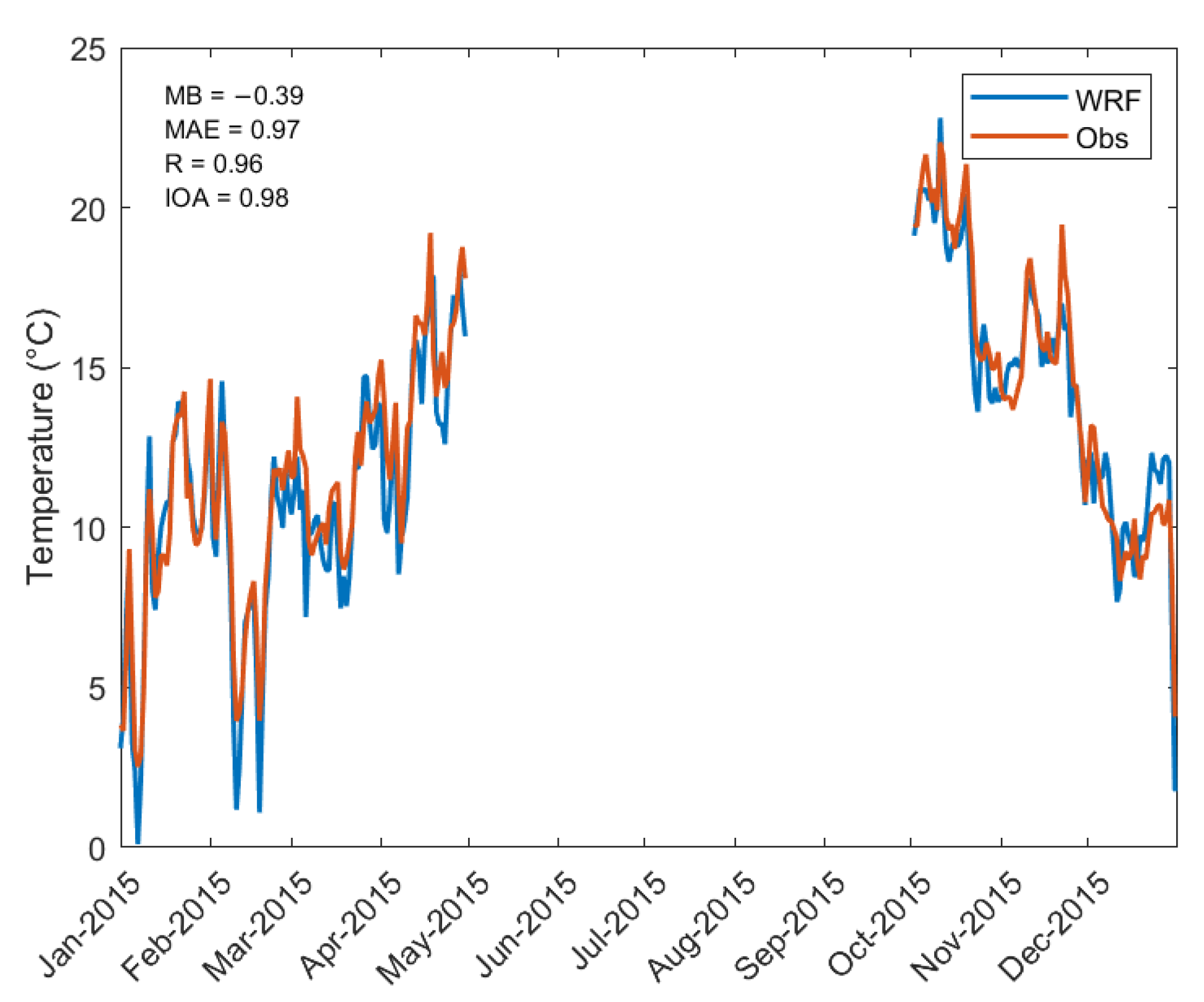
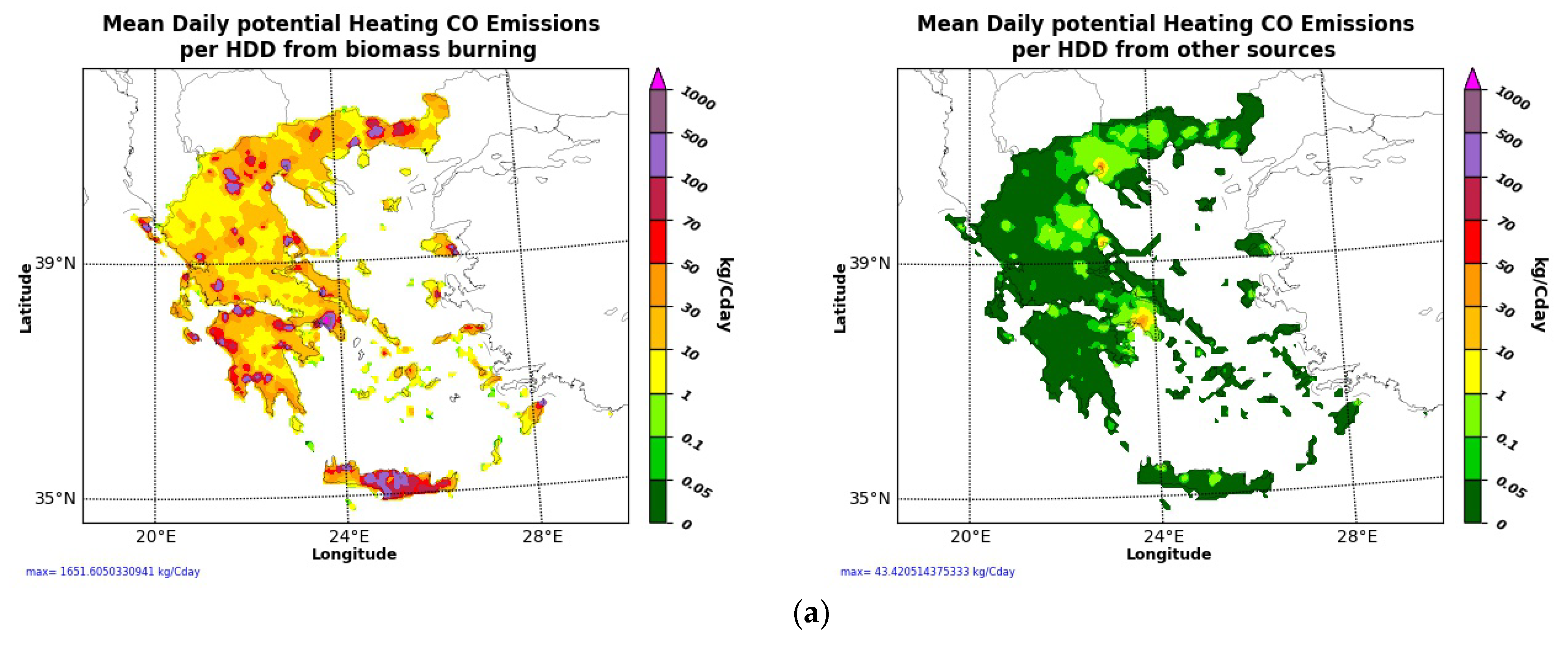
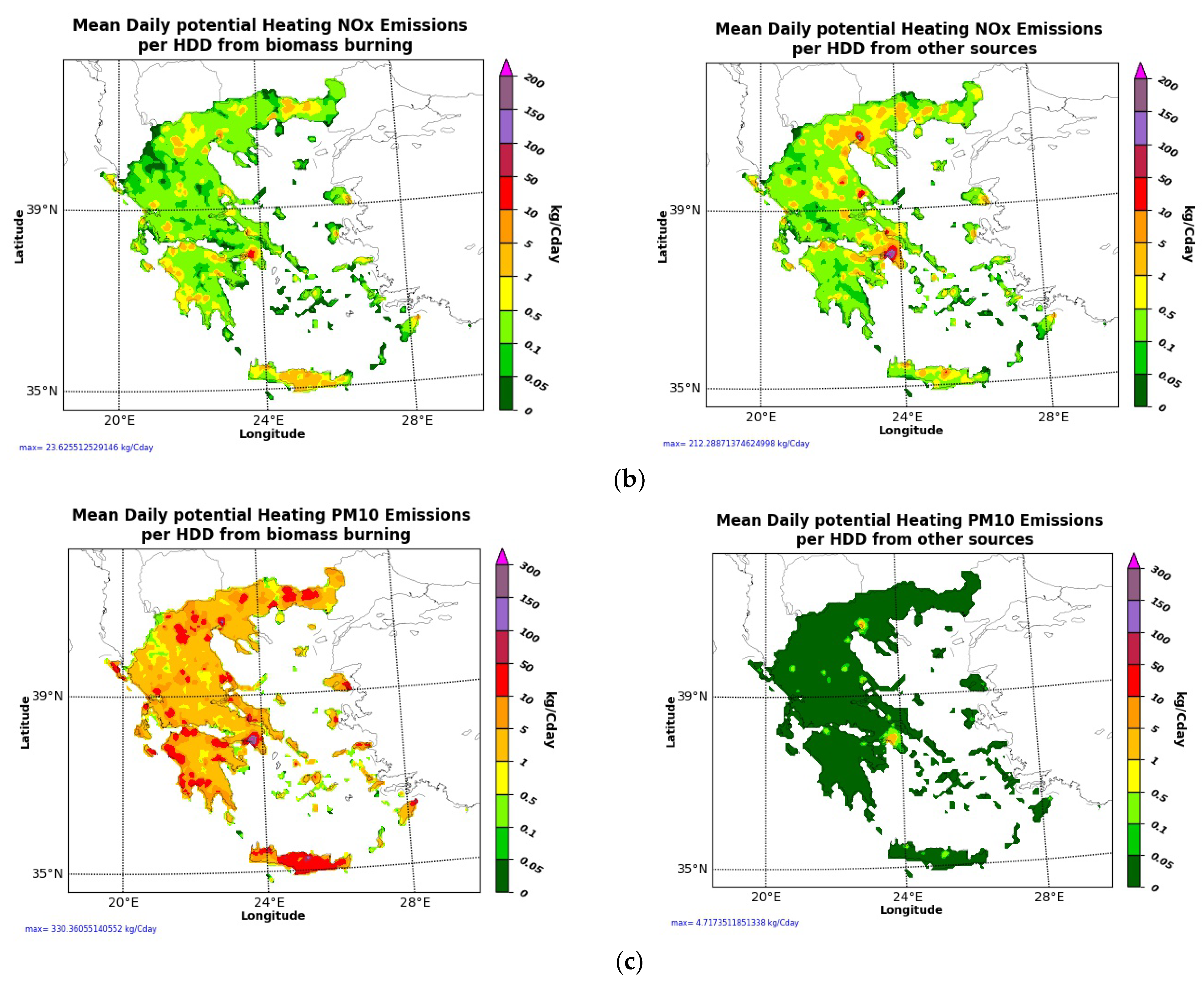
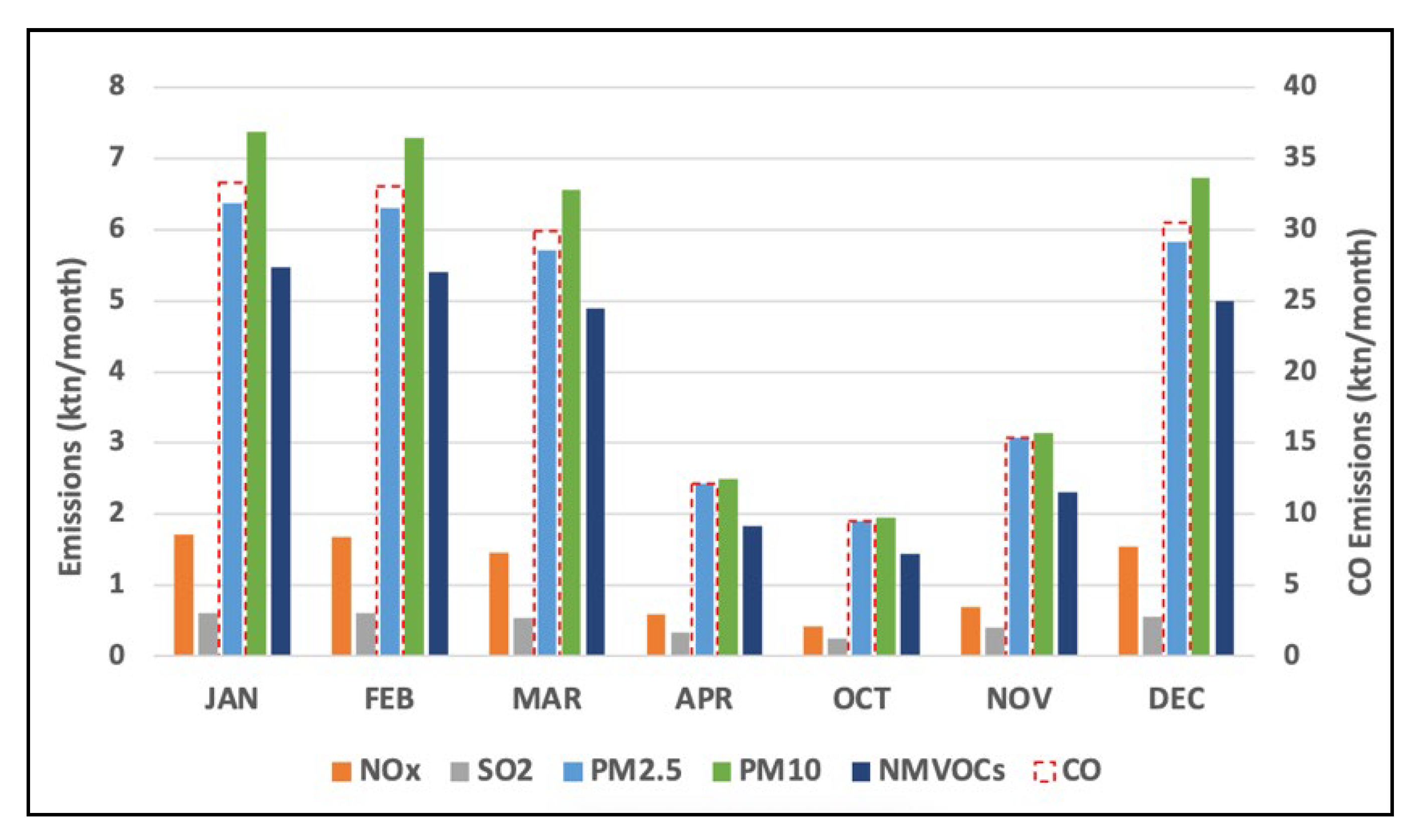
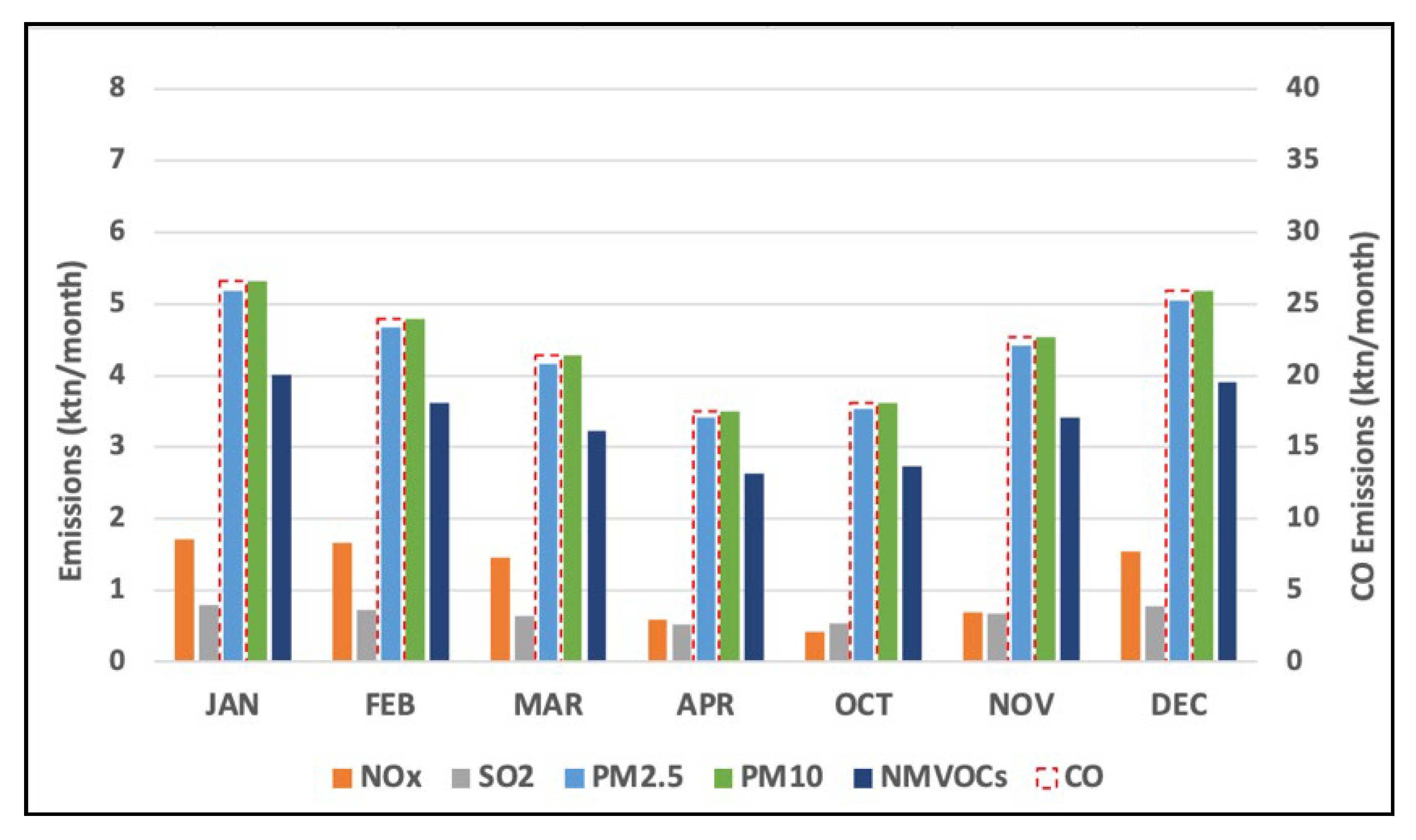
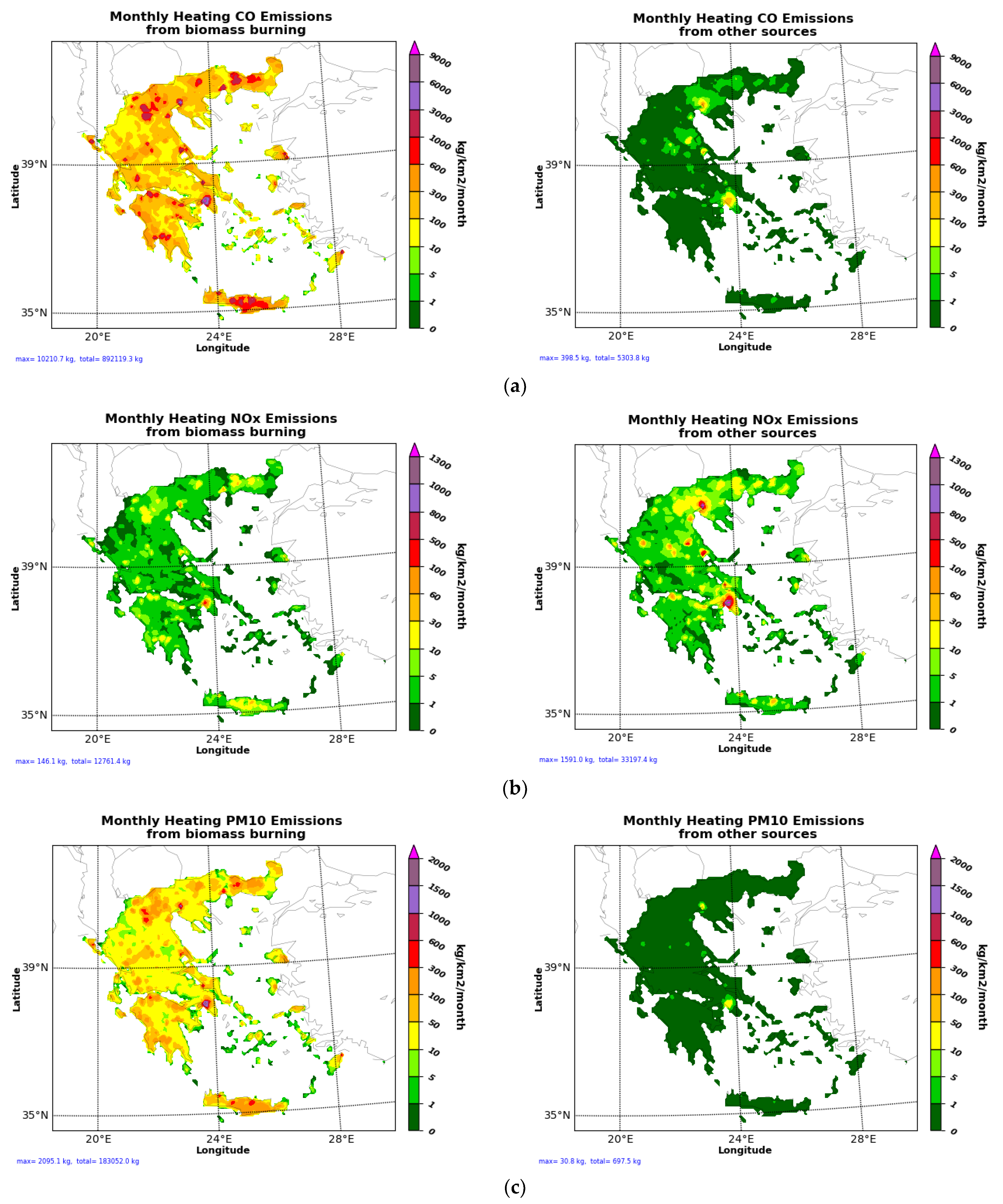
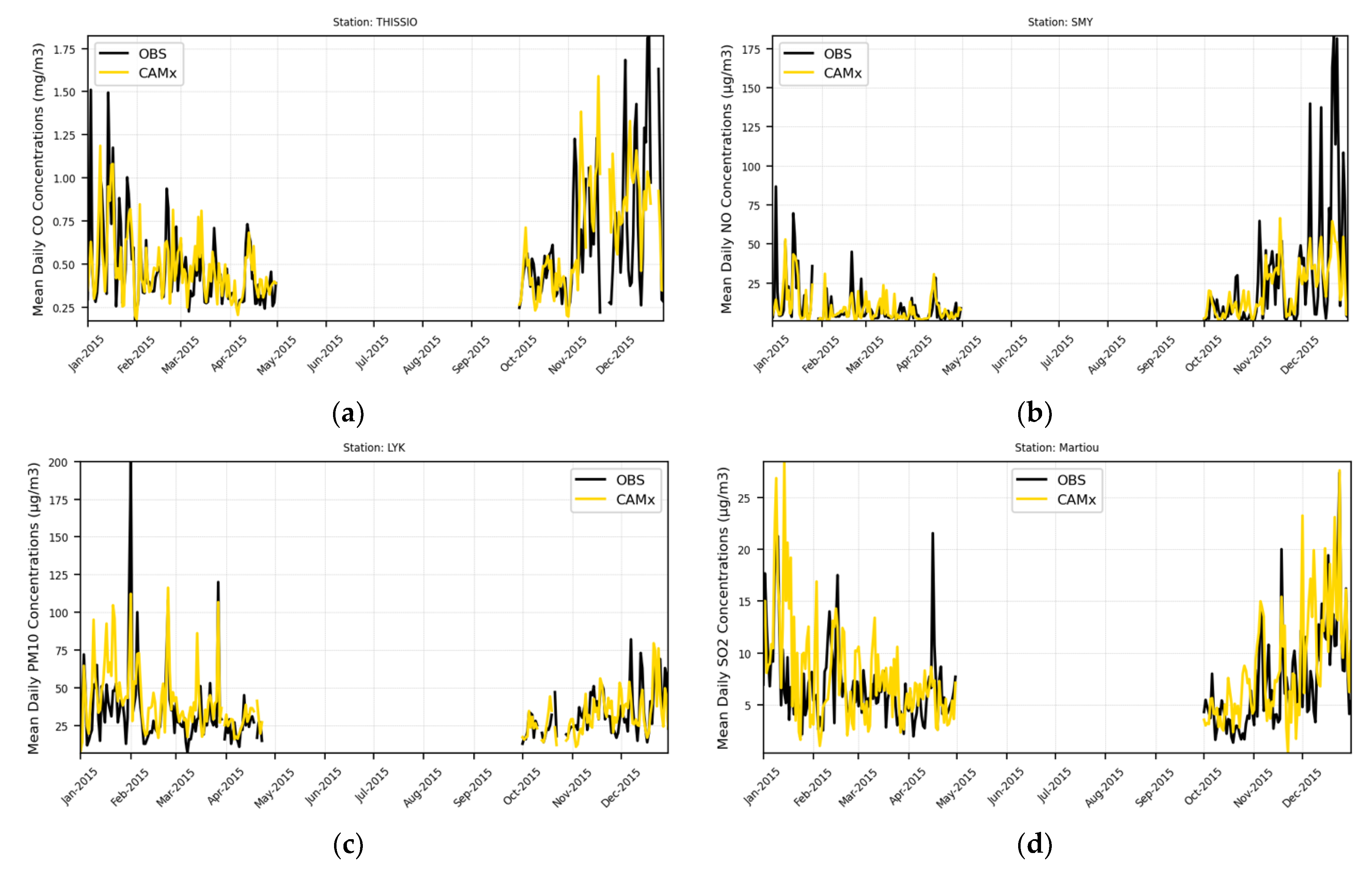
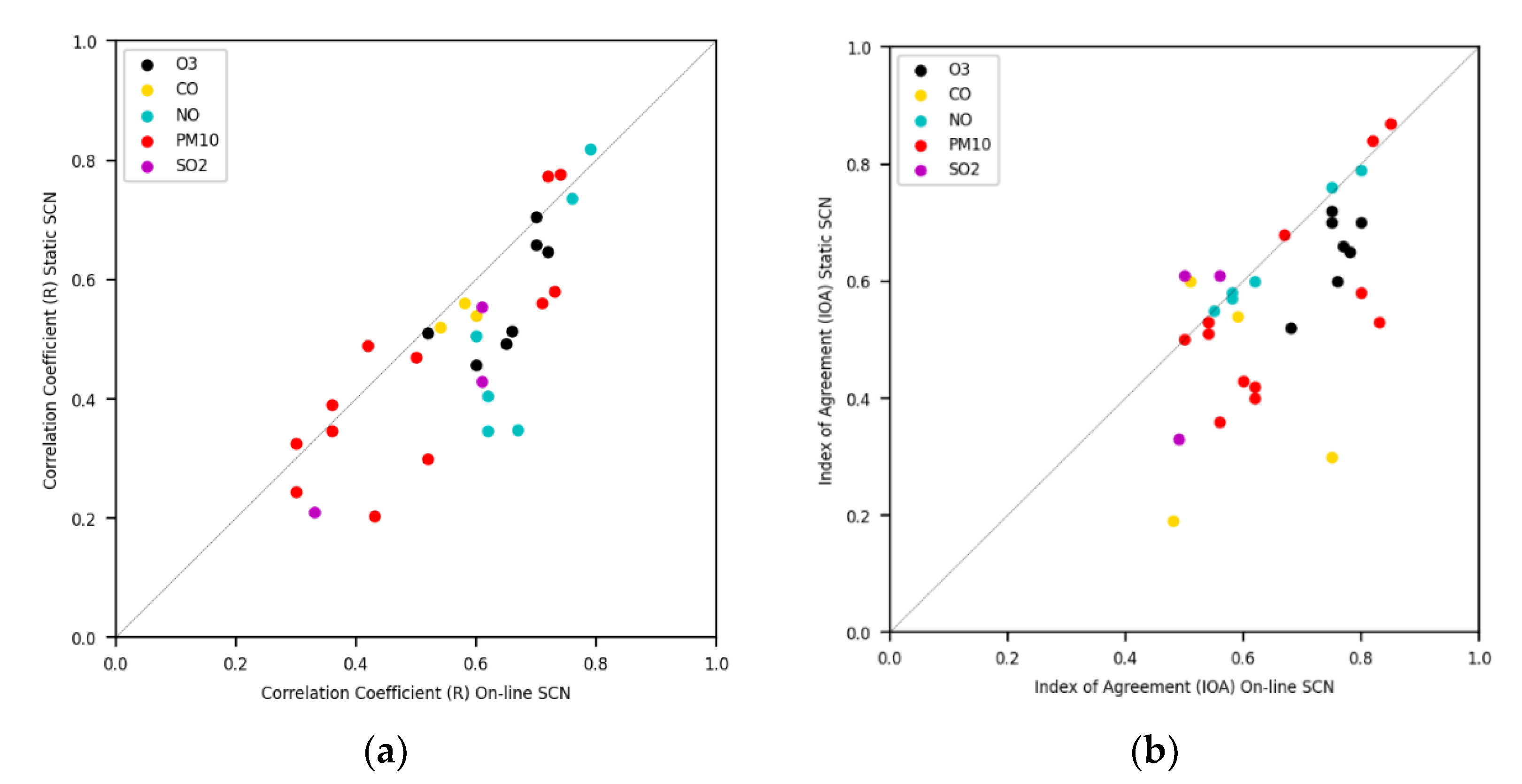
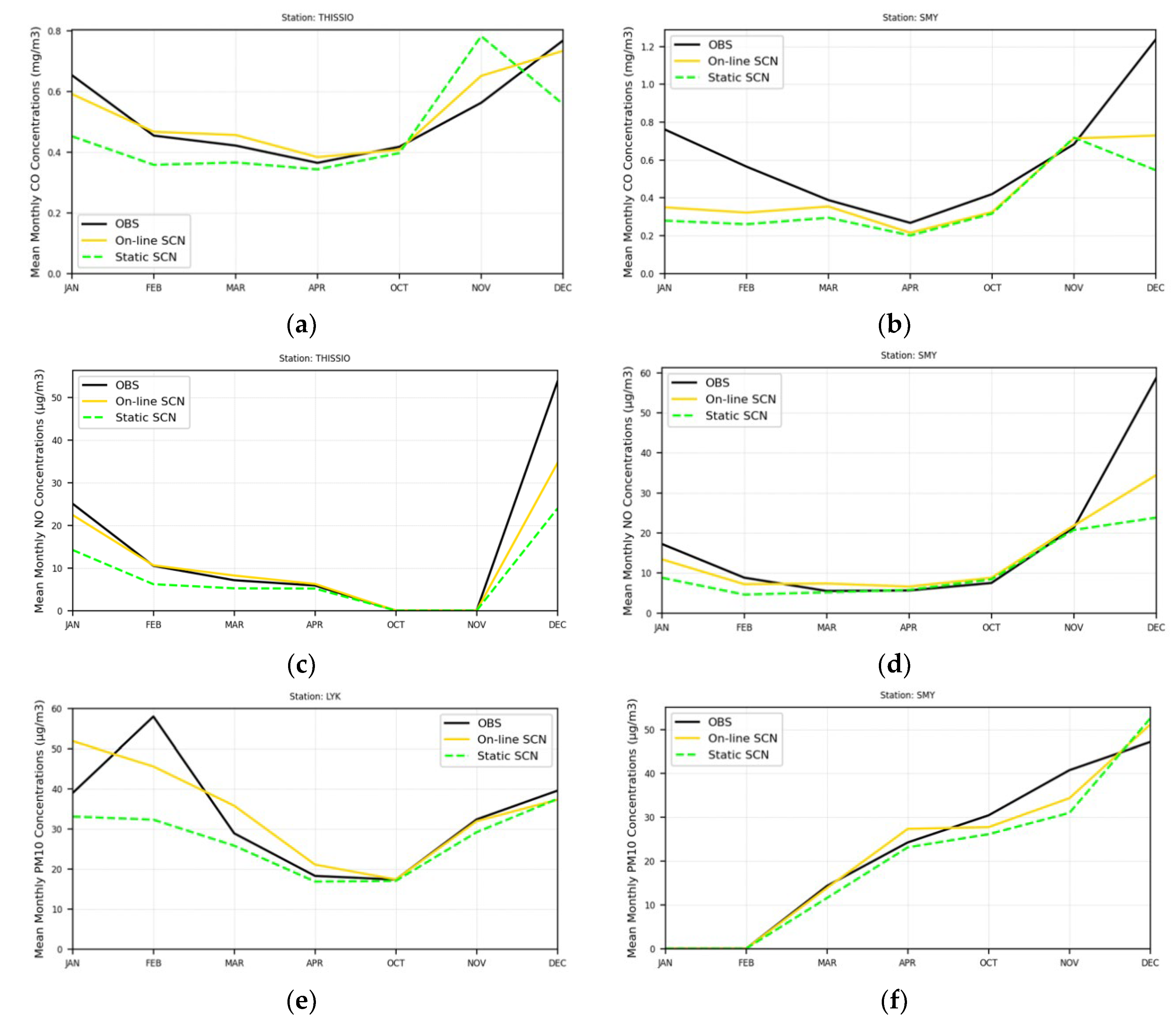
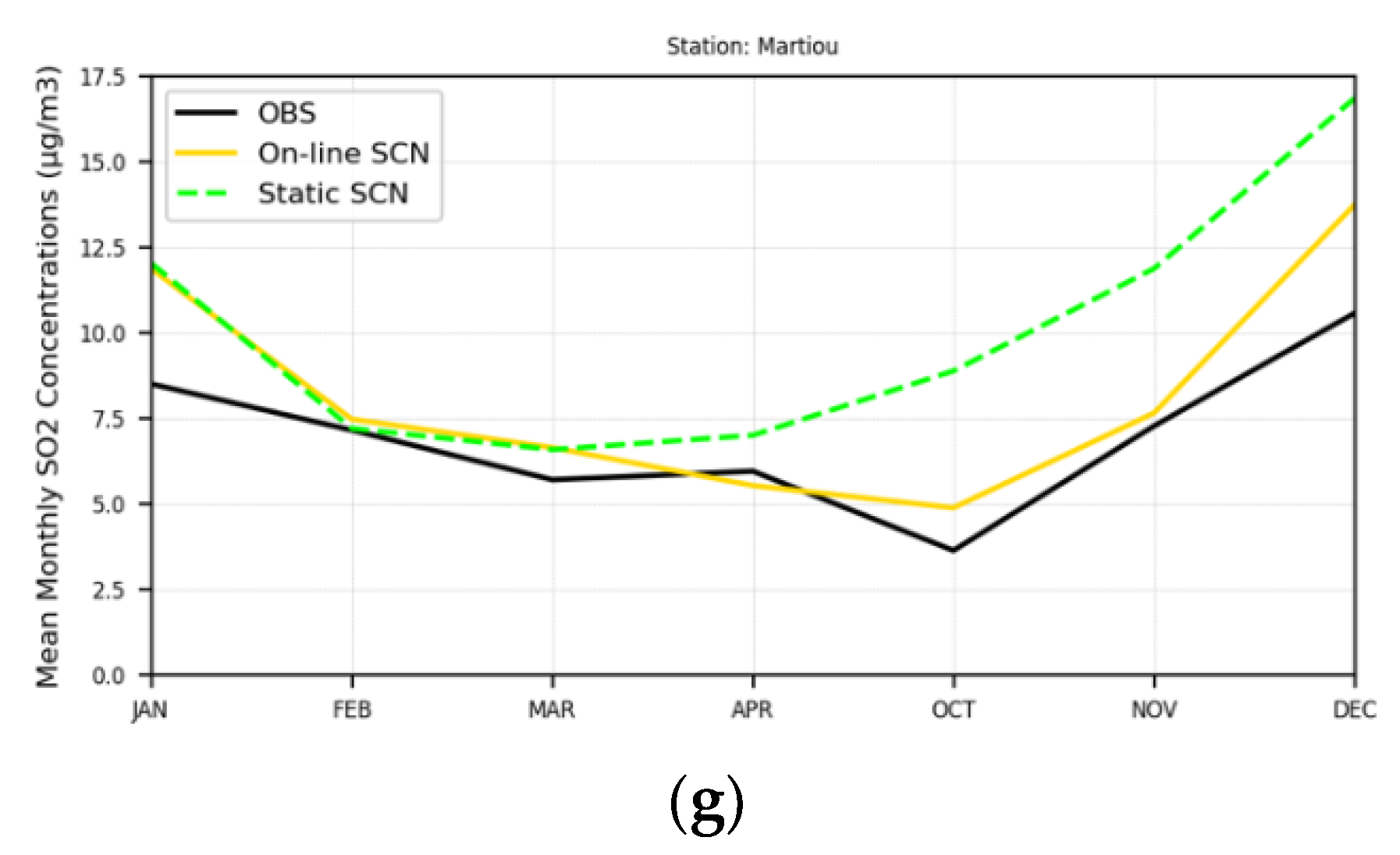
| Site Name | MB (°C) | MAE (°C) | R | IOA |
|---|---|---|---|---|
| Egnatia | −1.27 | 1.67 | 0.94 | 0.95 |
| Martiou | −0.38 | 1.27 | 0.95 | 0.97 |
| Athinai | −0.61 | 1.12 | 0.96 | 0.97 |
| Nea Smyrni | −0.84 | 1.10 | 0.97 | 0.97 |
| Larissa | −1.07 | 1.59 | 0.94 | 0.96 |
| Patras | −0.75 | 1.27 | 0.94 | 0.96 |
| Ioannina | 0.86 | 2.23 | 0.80 | 0.88 |
| Heraklion, airport | 0.90 | 1.16 | 0.96 | 0.96 |
| Site Name | Location in Greece | MB | Fac2 | R | IOA |
|---|---|---|---|---|---|
| PER | Athens | −7.5 | 0.85 | 0.70 | 0.80 |
| Thissio | Athens | −23.1 | 0.97 | 0.70 | 0.75 |
| SMY | Athens | −12.3 | 0.79 | 0.52 | 0.68 |
| LIO | Athens | −4.7 | 0.93 | 0.65 | 0.78 |
| KOR | Athens | 6.8 | 1.3 | 0.72 | 0.75 |
| AGS | Thessaloniki | 11.6 | 1.84 | 0.66 | 0.77 |
| KOD | Thessaloniki | −2.6 | 1.07 | 0.60 | 0.76 |
| Lagada | Thessaloniki | 4.2 | 1.2 | 0.53 | 0.72 |
| Martiou | Thessaloniki | 5.0 | 1.3 | 0.65 | 0.79 |
| Dimarxeio | Thessaloniki | 10.8 | 1.5 | 0.66 | 0.72 |
| Mean (Greece) | −1.2 | 1.18 | 0.65 | 0.75 | |
| Site Name | Location in Greece | MB | Fac2 | R | IOA |
|---|---|---|---|---|---|
| PER | Athens | −0.27 | 0.72 | 0.60 | 0.51 |
| Thissio | Athens | 0.01 | 1.14 | 0.58 | 0.75 |
| SMY | Athens | −0.22 | 0.87 | 0.54 | 0.59 |
| KAL | Thessaloniki | −0.21 | 0.65 | 0.59 | 0.48 |
| Mean (Greece) | −0.17 | 0.85 | 0.58 | 0.58 | |
| Site Name | Location in Greece | MB | Fac2 | R | IOA |
|---|---|---|---|---|---|
| PER | Athens | −2.1 | 1.04 | 0.36 | 0.62 |
| Thissio | Athens | 10.3 | 1.61 | 0.37 | 0.54 |
| SMY | Athens | 3.1 | 1.3 | 0.44 | 0.67 |
| Lagada | Thessaloniki | −2.8 | 1.05 | 0.53 | 0.73 |
| Martiou | Thessaloniki | −10.4 | 0.80 | 0.43 | 0.61 |
| Dimarxeio | Thessaloniki | −13.9 | 0.69 | 0.49 | 0.58 |
| Mean (Greece) | −2.6 | 1.08 | 0.44 | 0.63 | |
| Site Name | Location in Greece | MB | Fac2 | R | IOA |
|---|---|---|---|---|---|
| PER | Athens | −4.7 | 1.26 | 0.60 | 0.62 |
| Thissio | Athens | −4.1 | 1.80 | 0.79 | 0.80 |
| SMY | Athens | −3.6 | 1.60 | 0.76 | 0.75 |
| Lagada | Thessaloniki | −20.2 | 0.57 | 0.62 | 0.58 |
| Martiou | Thessaloniki | −19.9 | 0.54 | 0.62 | 0.55 |
| Dimarxeio | Thessaloniki | −16.5 | 0.62 | 0.67 | 0.58 |
| Mean (Greece) | −11.5 | 1.07 | 0.68 | 0.65 | |
| Site Name | Location in Greece | MB | Fac2 | R | IOA |
|---|---|---|---|---|---|
| AGP | Athens | 7.5 | 1.50 | 0.74 | 0.80 |
| LYK | Athens | 3.9 | 1.20 | 0.71 | 0.83 |
| SMY | Athens | −0.6 | 1.06 | 0.72 | 0.85 |
| Thissio | Athens | 18.7 | 1.93 | 0.52 | 0.62 |
| AGS | Thessaloniki | 0.2 | 1.17 | 0.50 | 0.67 |
| KOD | Thessaloniki | −5.5 | 1.10 | 0.43 | 0.60 |
| Malakopi | Thessaloniki | −10.5 | 0.87 | 0.35 | 0.56 |
| Martiou | Thessaloniki | −5.7 | 0.93 | 0.41 | 0.62 |
| IOA | Ioannina | −23.6 | 0.56 | 0.30 | 0.50 |
| LAR | Larissa | −15.2 | 0.83 | 0.36 | 0.54 |
| VOL | Volos | −11.9 | 0.73 | 0.30 | 0.54 |
| Mean (Greece) | −3.8 | 1.08 | 0.49 | 0.65 | |
| Site Name | Location in Greece | MB | Fac2 | R | IOA |
|---|---|---|---|---|---|
| Thissio | Athens | 18.7 | 2.0 | 0.33 | 0.49 |
| Martiou | Thessaloniki | 1.3 | 1.3 | 0.61 | 0.56 |
| Malakopi | Thessaloniki | 0.9 | 1.3 | 0.36 | 0.54 |
| Mean (Greece) | 6.9 | 1.5 | 0.43 | 0.53 | |
Publisher’s Note: MDPI stays neutral with regard to jurisdictional claims in published maps and institutional affiliations. |
© 2022 by the authors. Licensee MDPI, Basel, Switzerland. This article is an open access article distributed under the terms and conditions of the Creative Commons Attribution (CC BY) license (https://creativecommons.org/licenses/by/4.0/).
Share and Cite
Liora, N.; Kontos, S.; Parliari, D.; Akritidis, D.; Poupkou, A.; Papanastasiou, D.K.; Melas, D. “On-Line” Heating Emissions Based on WRF Meteorology—Application and Evaluation of a Modeling System over Greece. Atmosphere 2022, 13, 568. https://doi.org/10.3390/atmos13040568
Liora N, Kontos S, Parliari D, Akritidis D, Poupkou A, Papanastasiou DK, Melas D. “On-Line” Heating Emissions Based on WRF Meteorology—Application and Evaluation of a Modeling System over Greece. Atmosphere. 2022; 13(4):568. https://doi.org/10.3390/atmos13040568
Chicago/Turabian StyleLiora, Natalia, Serafim Kontos, Daphne Parliari, Dimitris Akritidis, Anastasia Poupkou, Dimitris K. Papanastasiou, and Dimitrios Melas. 2022. "“On-Line” Heating Emissions Based on WRF Meteorology—Application and Evaluation of a Modeling System over Greece" Atmosphere 13, no. 4: 568. https://doi.org/10.3390/atmos13040568
APA StyleLiora, N., Kontos, S., Parliari, D., Akritidis, D., Poupkou, A., Papanastasiou, D. K., & Melas, D. (2022). “On-Line” Heating Emissions Based on WRF Meteorology—Application and Evaluation of a Modeling System over Greece. Atmosphere, 13(4), 568. https://doi.org/10.3390/atmos13040568











